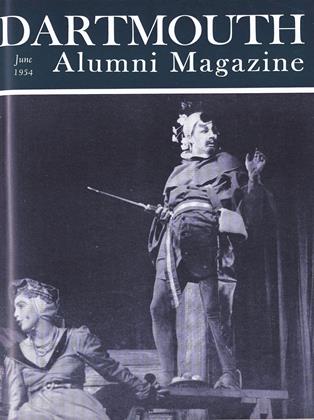HANOVER has recently enjoyed one of its periodic building booms, with new dwellings, for newcomers and old, sprouting in every environ. Toy Town, Sand Hill, and Downing Road are old hat now, since the frontier has been pushed across the northern end of the Chase Fields, out the West Leb Road on all sides of the new cemetery, up the Mink Brook Valley, over the Lewin Farm where the old slaughter house used to be, and to the precarious bastions of Balch Hill - now rechristened "Pill Hill" by reason of its appeal to physicians and surgeons. Modern architects of the Gropius-Harvard school love nothing better than to find an impossible terrain and pour into its undulations living units that are all picture windows and cellophane. They have dotted the landscape from Eastport to Block Island, and our village is no exception.
Another phenomenon of these latter days is the emergence of prefabricated dwellings - push-button pop-ups for Munchkins, gone today and here tomorrow, and surmounted by astounding TV antennae. Their great advantage is that when ennui sets in you can throw the house away and buy a new one, or if an unfortunate thermo-nuclear necessity temporarily reduces its charm as a habitation, you can take it apart, decontaminate the members, and re-erect on a less radioactive spot.
In our hey-hey day, houses were houses and not lightly to be tossed aside. Snug and sturdy, and put together with something other than stove bolts, they were more valuable than land, and if some special place utility dictated a different site, one moved the house and threw the old site away. This was particularly true whenever the College took a fancy to refine more carefully the academicness of any section of the village; and when the land around the Green became thus purified, and especially when Baker Library was built, the streets were clogged with dwellings, errant, seeking a local habitation and a name. Dunsinane come to Birnam Wood.
During the early years of the current century, the west side of the campus was cleared for variegated college buildings. The Bank was torn down and the Sanborn house pushed back toward the cemetery to displace the baseball cage,, become a dormitory for the semi-indigent (picture wall paper and all), and glare at the then fresh old Beta House. Eventually it gave way to Thayer Hall and the Betas moved to grander quarters, leaving to the Graduate Club their Wooglin-haunted halls.
The construction of Baker Library caused the greatest local displacement since Archimedes cried "Eureka. Reading clockwise from the White Church, we had first the Gable house - the old C. P. Chase house, the Jigger Pender house, and finally for a brief and stormy period, the Whee house. This structure eventually landed as the "Red" Greene house on East Wheelock Street - a cis-Skunk Hollow neighborhood which at that moment was crying for buildings. The Harry French-Dave Lambuth house - tall and yellow was torn down. As we recall, there was a house on the corner where Carpenter Hall now stands, which was also discarded. Sloping through the hollow on Elm Street was the long, low McWhood-Beetle house; on the corner of College Street, a structure that migrated east for Sidney Cox; and the Graduate Club which was winched inch by inch down East Wheelock and became several dwellings in the reaches of Toy Town.
When Butterfield Hall had to give way to Baker, Silsby was constructed to house its paleontologic tablets and its crocks of dead fish, driving to demolition the old (but not the oldest) halls of Kappa, and pushing the Ord Skinners and their Webster Cottage uptown and across the street to form a quadrangle with Choate and the Greenhouse.
Meanwhile, the old Gil Frost later Chi Phi - house trekked to South Park, the Fred Lord house mushed a little north to make way for the Steele Chemistry Building, and the little Episcopal chapel scurried from the rectory lawn on Main Street to South College when the fire station was transferred from the back of Phil's Cafe. Jigger Pender's barn has just finished a long and dishonorable service as a Field House on the Chase playing fields, and whatever happened to the Chinaman's barn behind the Inn, we haven't the vaguest.
The rolling of houses along thoroughfares must be a fading art. Nowadays we either chop up the old houses (and their barns) into faculty apartments or give them the complete Carthaginian treatment to free ground for less stately mansions.
 View Full Issue
View Full Issue
More From This Issue
-
 Feature
FeatureTHE EXPERIMENTAL THEATRE
June 1954 By HENRY B. WILLIAMS -
 Feature
FeatureNature Conditions Architecture
June 1954 By EDGAR H. HUNTER JR. '38, -
 Class Notes
Class Notes1918
June 1954 By ERNEST H. EARLEY, RICHARD A. HOLTON -
 Class Notes
Class Notes1926
June 1954 By HERBERT H. HARWOOD, ANDREW J. O'CONNOR, Richard Eberhart '26 -
 Article
ArticleThe Faculty
June 1954 By HAROLD L. BOND '42 -
 Class Notes
Class Notes1905
June 1954 By GEORGE W. PUTNAM, FLETCHER A. HATCH
BILL McCARTER '19
-
 Article
ArticleThe Hanover Scene
February 1953 By BILL McCARTER '19 -
 Article
ArticleThe Hanover Scene
January 1954 By BILL McCARTER '19 -
 Article
ArticleThe Hanover Scene
June 1957 By BILL McCARTER '19 -
 Article
ArticleThe Hanover Scene
October 1951 By BILL McCARTER '19 -
 Article
ArticleThe Hanover Scene
January 1958 By BILL McCARTER '19 -
 Article
ArticleTHE HANOVER SCENE
OCTOBER 1958 By BILL MCCARTER '19







